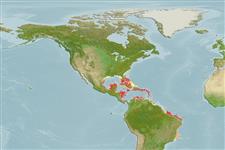Clathria schoenus (de Laubenfels, 1936)
| Native range | All suitable habitat | Point map | Year 2050 |

|
| This map was computer-generated and has not yet been reviewed. |
| Clathria schoenus AquaMaps Data sources: GBIF OBIS |
Upload your photos
Google image |
No photo available for this species.No drawings available for Microcionidae.
Google image |
No photo available for this species.
Classification / Names Common names | Synonyms | CoL | ITIS | WoRMS
Demospongiae | Poecilosclerida | Microcionidae
Environment: milieu / climate zone / depth range / distribution range Ecology
Sessile; brackish; depth range 1 - 35 m (Ref. 108813). Tropical
Distribution Countries | FAO areas | Ecosystems | Occurrences | Introductions
Western Central Atlantic.
Length at first maturity / Size / Weight / Age
Maturity: Lm ? range ? - ? cm Max length : 15.0 cm H male/unsexed; (Ref. 415)
Short description Morphology
Thinly encrusting: 0.2 - 0.4 cm thickness to lobate, ramose, palmate or flabellate, with thin branches reaching 10 - 15 cm in height. Very characteristically colored externally orange to red with yellowish tinges. Very smooth, somewhat slippery surface. Soft and compressible in consistency (Ref. 415).
Species grows on mangrove prop roots and seagrass beds (Ref. 86836). They are found in coral reefs and rocky bottoms (Ref. 83919).
Life cycle and mating behavior Maturity | Reproduction | Spawning | Eggs | Fecundity | Larvae
Members of the class Demospongiae are hermaphroditic. Life cycle: The zygote develops into parenchymella larva (free-swimming) before settling down on a substrate where it grows into a young sponge.
Main reference
References | Coordinator | Collaborators
Collin, R., M.C. Díaz, J. Norenburg, R.M. Rocha, J.A. Sánchez, M. Schulze, A. Schwartz and A. Valdés. 2005. (Ref. 415)
IUCN Red List Status (Ref. 130435)
CITES status (Ref. 108899)
Not Evaluated
CMS (Ref. 116361)
Not Evaluated
Threat to humans
Harmless
Human uses
| FishSource |
Tools
More information
Internet sources
BHL | BOLD Systems | CISTI | DiscoverLife | FAO(Publication : search) | Fishipedia | GenBank (genome, nucleotide) | GloBI | Gomexsi | Google Books | Google Scholar | Google | PubMed | Tree of Life | Wikipedia (Go, Search) | Zoological Record
Estimates based on models
Preferred temperature
(Ref. 115969): 26.3 - 28.3, mean 27.2 (based on 315 cells).
Price category
(Ref. 80766):
Unknown.


